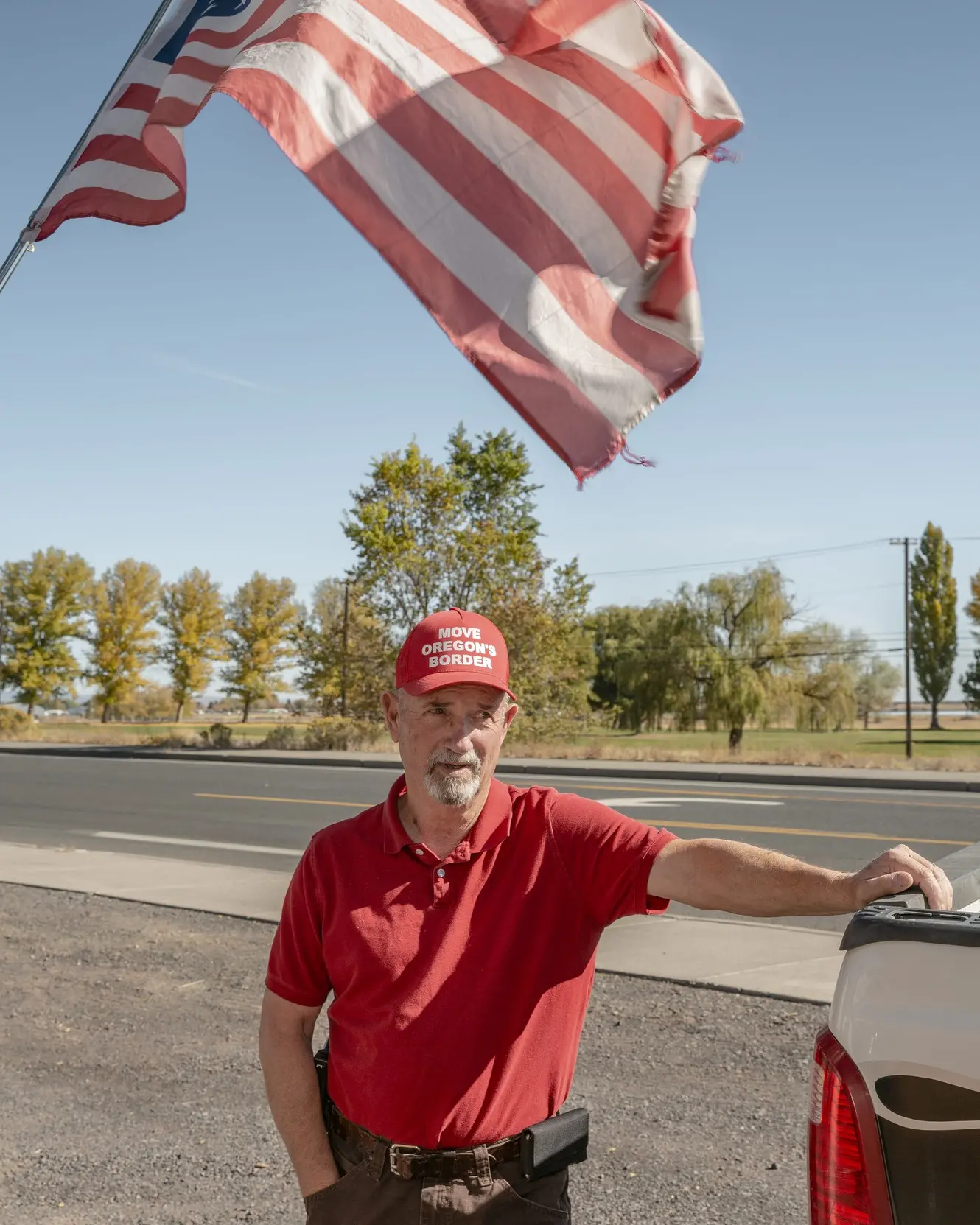
In the summer of 2015, a chimney sweep in Elgin, Oregon, redrew the map of the American West. “Imagine for a moment Idaho’s western border stretching to the Pacific Ocean,” Grant Darrow wrote in a letter to the editor of his local paper. Rural Oregon, he insisted, should break its ties with the urbanites of Portland and liberals of Salem, and join Idaho. “The political diversity in this state is becoming unpalatable,” he argued. “Rural Oregonians in general and Eastern Oregonians, in particular, are growing increasingly dismayed by the manner in which Oregon’s Legislature and Oregon’s urban dwellers have marginalized their values, demonized their lifestyle, villainized their resource-based livelihoods, and classified them as second-class citizens at best.”
In the half decade or so since Darrow’s diatribe, a simple and outlandish idea, percolating in rural Oregon since the 1960s—what if we were just Idaho?—has grown into a grassroots secession movement. Last month, Harney County, in the high desert of eastern Oregon, became the state’s eighth to pass a nonbinding ballot measure supporting Darrow’s proposal. "Move Oregon’s Border" signs now dot the region’s empty highways, and Mike McCarter, a retired agricultural nurseryman and gun-club owner who runs a group pushing for the boundary reshuffle, travels the state in a bright-red trucker hat bearing the slogan. “We don’t care to move, because we’re tied to our land here,” he told me recently. “So why not just allow us to be governed by another state?” He mentioned a supporter so certain that her property will become part of Idaho that she already flies its state flag on her lawn. “We’re going to be Idaho,” she told him.
Scenes from Portland, where Black Lives Matter protesters have sparred with the Proud Boys in paintball brawls over the past year, and worries that liberal lawmakers in Salem will outlaw diesel fuel and artificial insemination of animals, have calcified many rural Oregonians’ sense of total alienation from the west side of the state. “This is not the Oregon I know,” Sandie Gilson, one of Move Oregon’s Border’s “county captains,” told me. “We were farmers and ranchers and loggers. None of those values are left.” Today, half of Oregon’s population lives in the Portland metropolitan area alone. In eastern Oregon, Gilson pays for two emergency helicopter-airlift insurance plans in case she has to go to a hospital hundreds of miles away in Bend or Boise. “That huge drift of country is pretty much nonexistent in the American imagination,” the author William Kittredge wrote about this part of the state in Hole in the Sky, his 1992 memoir of his family’s life on a ranch. “It is hard to exaggerate the vastness of that barren playa. The whole of it—Lake and Harney and Malheur counties in Oregon, each as large as some states in the East—is still populated by no more than a few thousand people.” The geographic point in the continental United States farthest from any interstate lies in Harney County, a contemporary frontier so remote that, in 1990, a pair of census takers went missing for four days in the sagebrush trying to find a person.
It’s easy to scoff at the idea of honoring the proposed borders of “Greater Idaho,” not least because it’s almost inconceivable that both Idaho’s and Oregon’s legislatures would sign off on the proposal and send it to Congress for the necessary approval. Many conversations about the subject focus on “freedom” and diesel fuel, breezily dismissing questions of staggering importance in the West—water rights, public lands, the rights of Indigenous people—as details that will be ironed out later. The Greater Idaho proposal would grant Idaho more than three-quarters of Oregon’s land, more than 870,000 of its residents, and access to the ocean; most specifics beyond this have yet to be envisioned. “Idaho fits with what I feel,” Mike Slinkard, a fifth-generation Oregonian who makes high-stealth hunting clothing, told me. “Oregon left us out in the cold. We don’t exist.”
The reasoning comes across as amorphous and quixotic, but the Greater Idaho referendums have passed in eight out of ten counties where they’ve been proposed, making Move Oregon’s Border the most electorally successful secessionist movement in America today. Two more counties will vote on the measure next year, and this month, state Senator Lynn Findley begrudgingly said he’d consider introducing legislation related to the border move. Over the past decade, every state has flirted with a secessionist petition of some sort. Two-thirds of Republicans in the South are in favor of secession; elsewhere, Illinois counties are asking to be free of their directorate in Chicago, and West Virginia has just offered to take in three conservative-leaning, rural Maryland counties. Even this part of Oregon is nestled between areas that some people hope will become entirely new states: the State of Jefferson, in California, and the Liberty State, a libertarian utopia pushed by former Representative Matt Shea, in Washington. The Greater Idaho solution appeals in part because of its political pragmatism; moving a border is hard, but it’s easier than creating a new state.
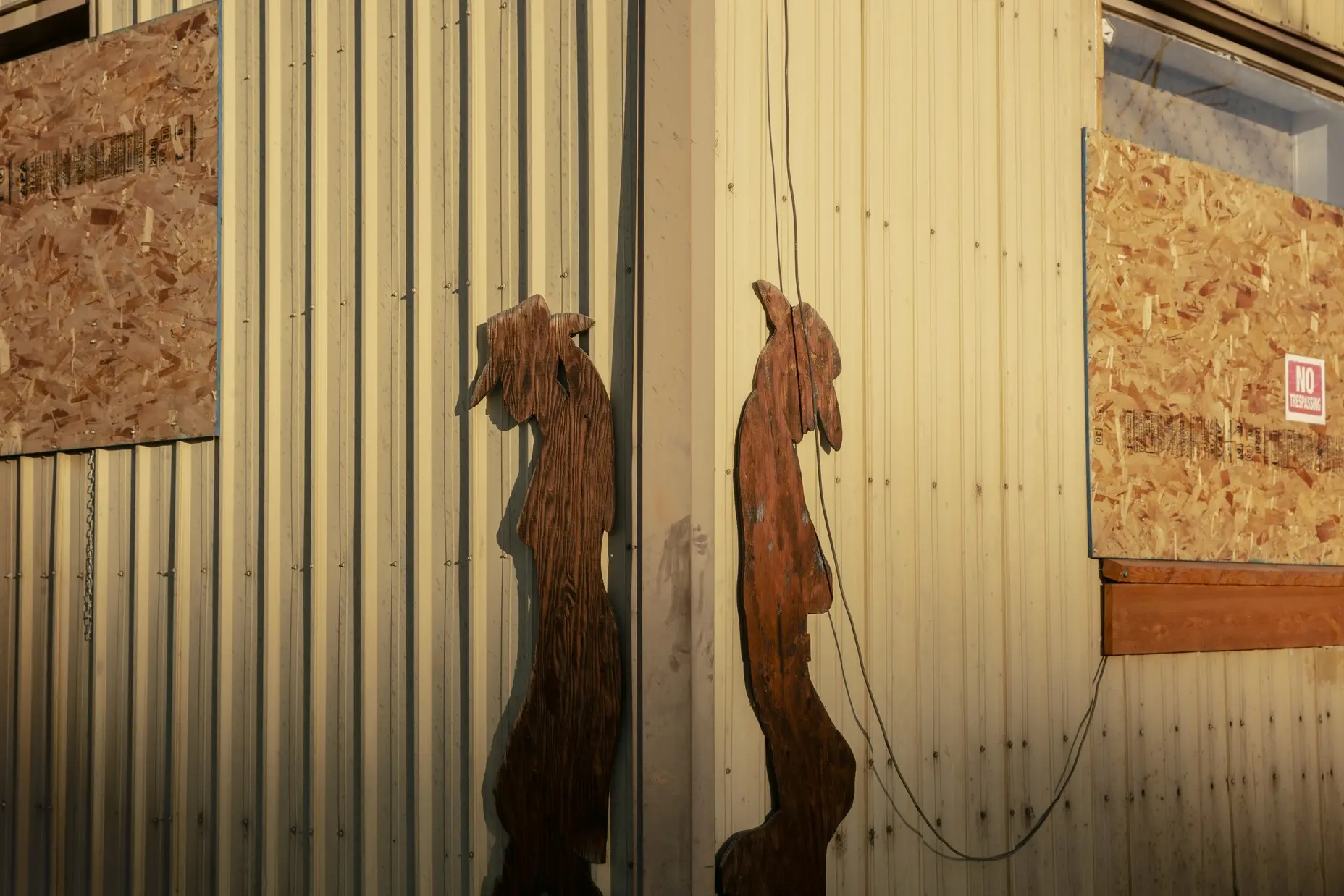
McCarter, the main organizer behind the ballot measures, lives in a mobile home in La Pine, half an hour south of Bend, the eco-chic outdoor-destination town in central Oregon. When I visited last month, a sign outside his property advertised his concealed-carry-permit business, and an American flag flew above the door. Jason Mraz played on Sirius radio from a TV flanked by two paintings of McCarter’s black Labrador; a Bible and a box of Milk Duds sat on the end table. If the border reflected the lines as McCarter envisions them, Bend, with its cashew milk and Teslas and mandatory masking at craft breweries, would be in a different American state from his home. For McCarter, such a severing is commonsense, and the map of Greater Idaho, carefully carving out Bend, doesn’t look any more puzzling than a gerrymandered congressional district. The urban-rural divide is so intense that separating the two is the most sensible path forward, he told me.
Joining Idaho would keep rural Oregon the way America used to be, McCarter explained. In his narrative, Salem is the villain forcing eastern Oregon counties to comply with laws that seem irrelevant or offensive to their rural setting, rules that have no bearing on their lived reality. Recent redistricting only compounded the sense that representation would never skew in their favor; McCarter feels his supporters’ voices are drowned out by urban ones—the culture over the hill, across the Cascades. Portland is in the midst of its most violent year ever, including more than 1,000 shootings so far. Struggling economically and anticipating the full collapse of industries that used to sustain them, McCarter and his group clamor for popular sovereignty.
Move Oregon’s Border’s true purpose is threefold, McCarter told me: First, obviously, to move the border. Second, to send a message to the state legislature “that you’ve got some very unhappy people, and here are the reasons why.” But the third is more subtle: “It provides a vent for all this anger.” McCarter sees himself as a peaceful guy proximate to violent movements. When he retired from working in plant nurseries and started running a gun club, members of the Oath Keepers, the Three Percenters, and the Project Appleseed prepper group practiced at his shooting range. People’s Rights, the anti-government activist Ammon Bundy’s new far-right network, has asked him to speak at its events. “I know there’s some people that have talked about ‘If this continues on, people are going to pick up their guns,’” McCarter said. “Rural people—their values, the way they live, their faith, their freedom—are closely tied to what Idaho is, so why not adjust the border? Just let us go peacefully.”
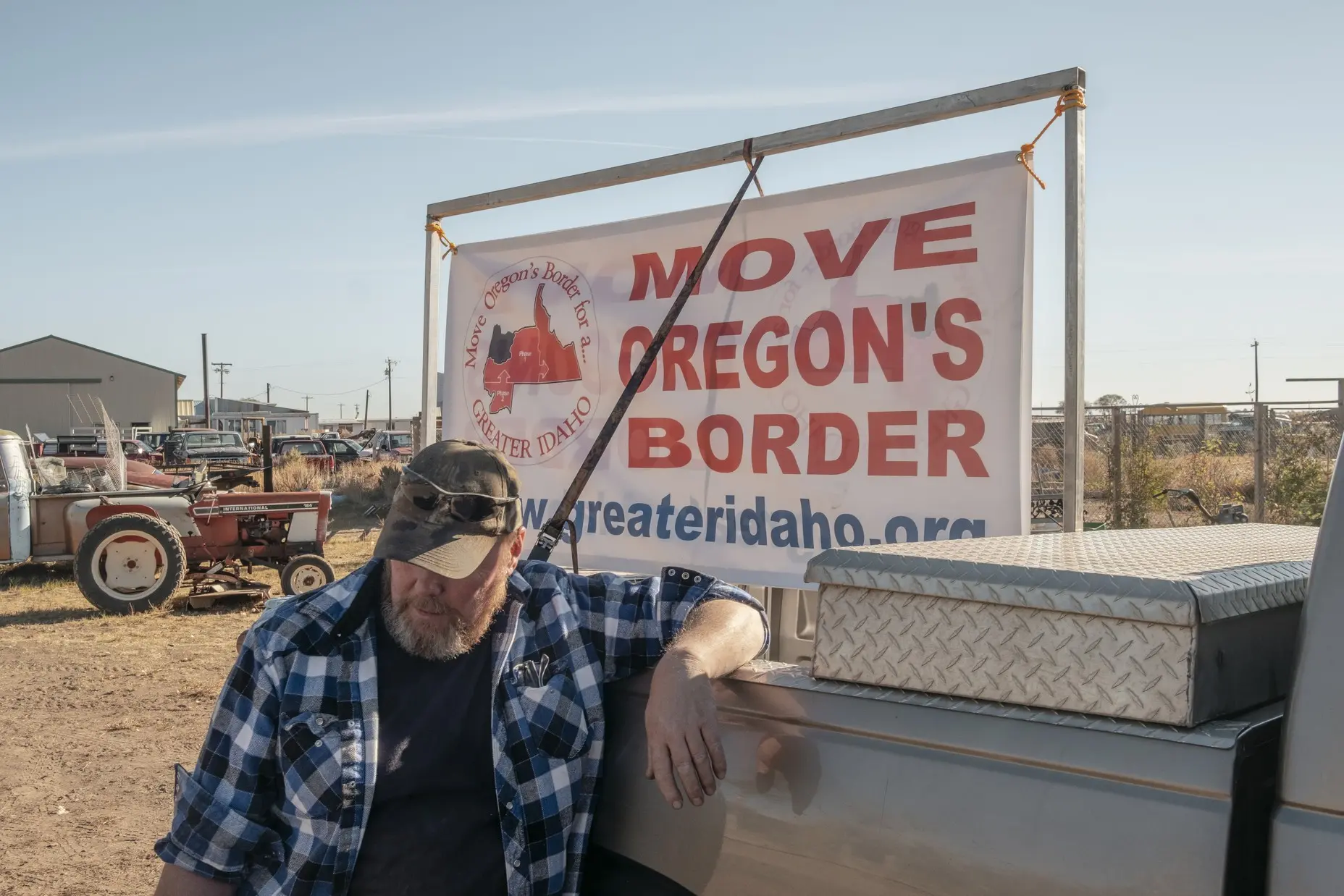
That this part of the world would find secession and separatism so compelling makes sense, Richard Kreitner, a historian and the author of Break It Up: Secession, Division, and the Secret History of America’s Imperfect Union, told me. The idea of separation as a solution to intractable political disputes is part of the history of Oregon; even at its formation, some were certain that it would eventually fragment or join California. Perhaps we needn’t be so precious about redrawing borders, Kreitner told me. “State lines aren’t written in stone, and the Oregon proposal shouldn’t be dismissed out of hand,” he said. “The idea of secession is being normalized in an unwinding and degrading country … This is considered a peace proposal, or a way to avoid war.”
Greater Idaho supporters I met often articulated the movement’s aims in the same terms McCarter and Kreitner used. “This is actually very American, choosing our own government,” Gilson, the county captain, told me. “It was all about choosing our government when we left England in the Revolutionary War.” Some proponents of Greater Idaho swiftly offer another American revolution—or another civil war—as the backup plan if moving the border doesn’t work out. The aesthetic of armed politics is still ingrained in recent memory in eastern Oregon; just five years ago, in Harney County, Bundy led a 41-day armed takeover of the Malheur National Wildlife Refuge that led to a standoff with the federal government. (The state police shot and killed LaVoy Finicum, a leader of the occupation, at a roadblock between the refuge and the nearby town of John Day; they claim he was reaching for a gun.) Eighty-five percent of people in Harney County carry a concealed weapon.
In McCarter and his allies’ eyes, they’re preserving a version of the last American frontier—lands still unfettered by the progressive ideas from cities such as Portland that are seeping into every place in America and threatening rural life. It’s a charming myth. “The frontier fantasy of armed white men who made the West and can remake it because they are autonomous or independent from political forces back east is something that really probably fires the imagination of a lot of people,” the historian Joe Lowndes, of the University of Oregon, told me. Localism, autonomy, and regionalism are entrenched in the literary imagination of Oregon—take, for example, Don Berry’s Trask and Ken Kesey’s Sometimes a Great Notion. Greater Idaho is adjacent to the bioregion of Cascadia and the environmental utopia of Ernest Callenbach’s Ecotopia, as well as to the “American Redoubt,” a supposed haven for survivalists in the sparsely populated lands of Montana, Idaho, and the eastern sides of Washington and Oregon—“the last refuge of the American patriot,” as a Redoubt-centric real-estate company describes it. (“Rural America gives you ultimate freedom and safety far away from the Sanctuary City,” the firm promises.)
Oregon was itself founded in dispossession. Its constitution banned free Black people from living in the state. “It’s difficult to disentangle the nonthreatening parts of this group from the threatening white-supremacist aspects, because the region gained a reputation as a safe home for these ideas,” Steven Beda, a historian at the University of Oregon, told me. “It’s about articulating a rural identity, a return to a rural past; and ruralness is frequently used as a synonym for whiteness. Nostalgia is often rooted in white-supremacist ideals—‘we were all better off before people of color started demanding rights.’” Most supporters I spoke with skewed toward retirement age; they diligently collected signatures at farmers’ markets and gun shows and chatted in small groups at thinly attended meetups in church basements, peddling a far-fetched cause among their neighbors. But McCarter mentioned to me in passing that some supporters had gone to Washington, D.C., on January 6. A conservative-leaning separatist movement isn’t definitionally exclusionary or violent, but movements like Greater Idaho can’t be entirely decoupled from the context of menacing and violent right-wing organizing in the region. The Patriot movement, a set of anti-government conspiracist militias, remains active today, and Timber Unity, a rural solidarity group with extremist connections, gives money and support to county-commissioner candidates, including many who go on to win.
Much of Oregon’s history was “driven by an understanding of violence as a commonplace method of solving problems,” Kittredge, the rancher memoirist, wrote. The Greater Idaho movement’s more avid supporters say Darrow’s idea is the only thing keeping them from an insurrection. “A flash point is coming,” Gilson told me. “People are ready to fight; I’m hoping that it’ll be a push for Move Oregon’s Border—that it won’t be violent. Moving the border is a civil answer. Eastern Oregon is known for its guns.”
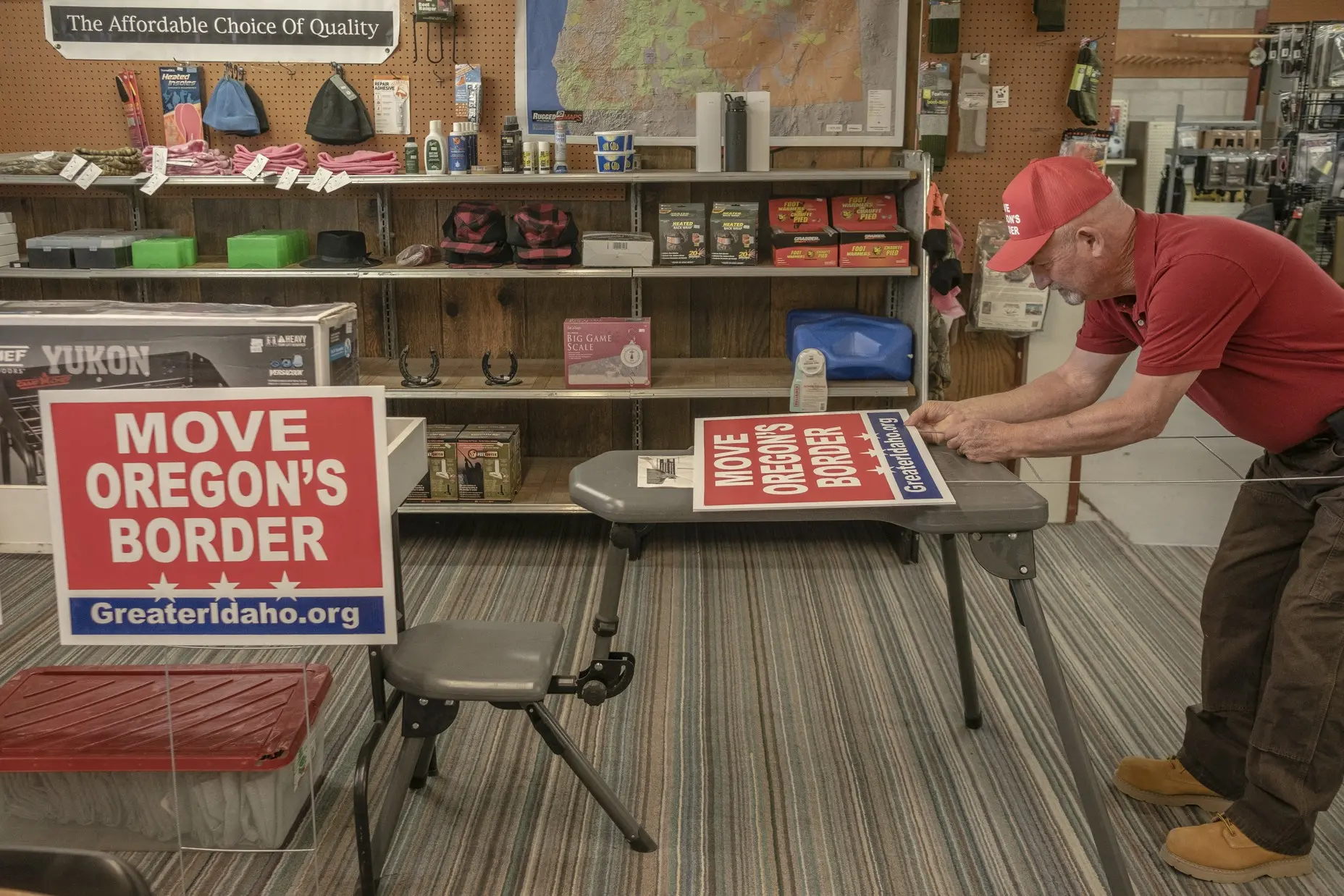
The weekend before Harney County voted on the referendum, McCarter held a rally at a sporting-goods store in Hines. He called to warn me not to expect a huge crowd. Midday on Saturday, he set up a round table with Black Rifle coffee and a neatly arranged array of Move Oregon’s Border hats and leaflets. He stood smiling in the empty shop with a pistol on his hip, surrounded by rifles and fishing gear. “Portland this year looks like when I rolled into Baghdad for the first time,” Dean Brizendine, a former cop who owns the shop, told me from behind the gun counter. Toni Foster, Move Oregon’s Border’s Harney County captain, made snickerdoodles and drove over from the auto wrecking yard in town, where her repair shop and mobile home sit amid rows of half-scrapped classic cars and trucks. Her husband, Gary, a former heavy-machinery operator, stood in the corner, scrolling on his phone. “They just overrun us on the other side of the mountain,” he said.
The first visitor to arrive was a woman wearing a shirt that said "Be more American" who came to yell at McCarter, with her daughter and granddaughter in tow. “Idaho doesn’t want us—I moved out of Idaho for a reason!” she shouted, standing over the table. Her son has seizures and needs medical marijuana, which is legal in Oregon, but not Idaho. (Marijuana came up nearly as often as diesel fuel in my conversations about the border move.) “I’ll still vote for it, though, because of the values,” she said. She shook McCarter’s hand and went to buy a gun at the register. A few others filtered in and out over the next hour to either purchase a firearm or approach the table and ask about Greater Idaho. Nancy Cronin had driven down Highway 395 from where she lives on a ranch, retired and off the grid, to find out more about the movement and whether she would end up becoming a resident of Idaho. McCarter stood and talked with her. She said she was undecided.
“There’s no death tax in Idaho,” McCarter said.
“That’s a plus,” she responded.
“And Idaho has a balanced budget,” he said. Another plus.
She asked whether Idaho would accept her daughter’s beautician license. McCarter told her those are the sorts of questions they’d still have to work out.
“Is this going to happen in our lifetime?” Cronin asked. “Texas has been dealing with this for 20 years. I’m 70.”
“Look,” McCarter said, “it’s a vent, instead of people picking up their guns.”
“If it gives people a place to put our energy, our frustration—I’m for it,” she said.
Cronin turned to me. “And people are getting close!” she said. “Anarchy! Not just in Oregon. But what happened down on the refuge at Malheur is a symptom of it. It’s a passion of the people who live in rural Oregon—and this is an avenue for folks instead of doing something illegal that wouldn’t get you where you want.” She leaned on the counter.
“It’s not perfect,” McCarter said. “And it may morph into something else.”
“We just need to show the Oregon legislature that it’s possible,” Cronin said.
“They haven’t listened in 20 years,” McCarter responded.
“We have to reinstitute the Founding Fathers’ fire, because we’re back there again,” Cronin told me. “And this seems like a place to take intellectual ideas, instead of a violent way. It would finally feel like we have some control and stake.” She left with one of McCarter’s pamphlets featuring the map of Greater Idaho.
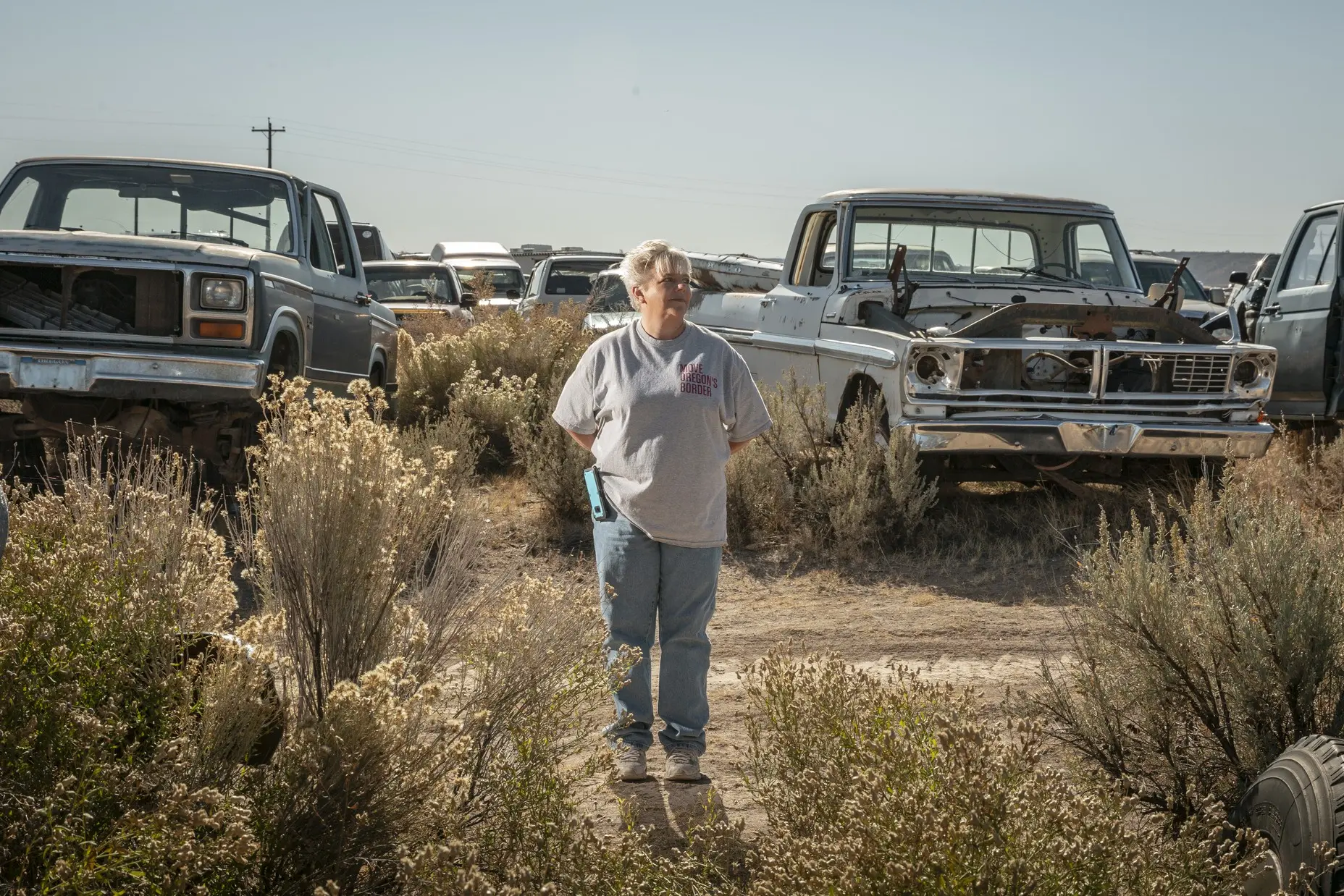
Plenty of rural Oregonians balk at the suggestion of becoming Idahoans. I spoke with many who see themselves as the less vocal majority, and some who’d never even heard of the measure. “We would only lose by becoming part of Idaho,” Isabelle Fleuraud, a yoga teacher who helped establish the Harney County Democrats during the Bundy standoff, told me. “It’s like a John Wayne movie, that imaginary ideal past of Harney County.” She told me she was exhausted by Greater Idaho supporters’ tendency to blame faraway Democratic overlords—Oregon Governor Kate Brown in Salem, and the federal government in D.C.—for all of the region’s ills.
Joining Idaho is a “mind-bogglingly oversimplified” notion, Steve Grasty, a retired Harney County judge, told me. Counties such as Harney are hugely dependent on federal funding; Oregon’s second congressional district, which covers the entire eastern swath of the state, was the nation’s biggest recipient of Affordable Care Act funds. But even Grasty, who used to travel to Salem to advocate for the county, admitted that the legislature there didn’t seem interested in the stories and problems he brought from rural Oregon. “Over and over, I worked to put that rural perspective into focus, and it really didn’t get heard.” He could have changed parties, but stayed a Democrat just so people on the west side of the state would talk to him, he told me.
The border move might seem preposterous: a peaceful rebellion fantasized about by a handful of people sitting around a sporting-goods store eating cookies and practicing amateur cartography. But some are bluntly resigned to another conclusion—one of my last stops in Harney County was a visit to Ben Holloway, the owner of Spent Cartridge, the local gun shop. He thinks the border question “will probably boil more down to a revolution rather than even worrying about moving this and that,” he told me. “It would just be right out to war, a civil war or splitting her up.” He went on, “And that’s the rise and fall of every civilization in history. The United States has been at the top for a long time. We’re where Rome was when Rome was at its peak, and eventually everything comes crumbling down. It will be pretty much just like the Civil War back when, North versus South. It might be more East versus West, urban versus rural. It will be absolutely horrible and terrifying and frightening. A lot of people dying for no reason. But eventually they’re going to push a group far enough that they have no other recourse, in their mind.”
I asked Holloway how it would feel if the border move somehow shook out—if at the end of a prolonged political process, he and I could factually say we were standing in Idaho, not Oregon, that afternoon.
“I don’t think it would hardly change a thing, to be honest with you,” he said.











